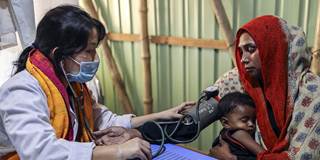Last year’s United Nations report on progress toward achieving the SDGs showed that the number of people facing hunger is actually growing, as is the number of malaria cases. This is disappointing, but not surprising.
WASHINGTON, DC – In 2015, the world committed to achieving the Sustainable Development Goals – a comprehensive agenda covering virtually all aspects of development – by 2030. But the world has yet to embrace the kind of deliberate, systematic, and inclusive approach that is needed to eliminate inequities that prevent billions of people from enjoying a long and healthy life.
Last year’s United Nations report on progress toward achieving the SDGs showed that the number of people facing hunger is actually growing, as is the number of malaria cases. Moreover, according to the Intergovernmental Panel on Climate Change, the consequences of climate change are emerging much faster than anticipated. The world’s poorest and most vulnerable will be disproportionately affected.
This is no way to fulfill the pledge contained in the SDG framework, called the 2030 Agenda for Sustainable Development, that “no one will be left behind.” But it should not come as a surprise. The world has made limited efforts to eliminate inequities, including in health. The SDGs’ predecessor, the Millennium Development Goals, brought modest improvements in health equity for many countries, but in a substantial minority of countries, poorer segments of the population fell even further behind.

WASHINGTON, DC – In 2015, the world committed to achieving the Sustainable Development Goals – a comprehensive agenda covering virtually all aspects of development – by 2030. But the world has yet to embrace the kind of deliberate, systematic, and inclusive approach that is needed to eliminate inequities that prevent billions of people from enjoying a long and healthy life.
Last year’s United Nations report on progress toward achieving the SDGs showed that the number of people facing hunger is actually growing, as is the number of malaria cases. Moreover, according to the Intergovernmental Panel on Climate Change, the consequences of climate change are emerging much faster than anticipated. The world’s poorest and most vulnerable will be disproportionately affected.
This is no way to fulfill the pledge contained in the SDG framework, called the 2030 Agenda for Sustainable Development, that “no one will be left behind.” But it should not come as a surprise. The world has made limited efforts to eliminate inequities, including in health. The SDGs’ predecessor, the Millennium Development Goals, brought modest improvements in health equity for many countries, but in a substantial minority of countries, poorer segments of the population fell even further behind.